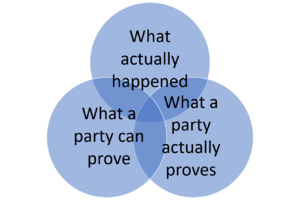Torts notes
Reading comprehension
Reading and math skills
Some procedure
Burdens of proof
In Black's Law Dictionary, look up:
- Burden of proof
- Burden of pleading
- Burden of production
- Burden of persuasion
Standards of proof
Black's Law Dictionary defines "standard of proof" as "[t]he degree or level of proof demanded in a specific case, such as 'beyond a reasonable doubt' or 'by a preponderance of the evidence'; a rule about the quality of the evidence that a party must bring forward to prevail."
Preponderance of the evidence standard
In most (but not all) contexts, the standard of proof in a tort action is "a preponderance of the evidence." In an 1895 case, the South Carolina Supreme Court approved of the following jury instructions given by the circuit court judge to the jury in a civil case:
I charge you that should you not be satisfied by the preponderance of the evidence that the defense of the defendant is sustained, then you will have to consider the case as made out by the plaintiff; and then upon him will fall the burden of proof to make out his case by the same standard, the preponderance of the evidence. By that is meant, Mr. Foreman and gentlemen, the greater weight of the testimony on the issues involved. No court can provide a jury with scales on which to weigh the evidence; but a jury of twelve intelligent men, who have a knowledge of human nature, and, from their observation of life, understand the rules of common sense, are in possession of the best scales on which to weigh evidence. When a jury comes to the conclusion that a defendant has brought forward evidence that satisfies them that, more likely than not, such and such was the case, then they may say he has established his defense by the preponderance of the evidence; or when the plaintiff satisfies the jury by competent evidence that it is more likely than not that such and such was the case, not absolutely proved, not absolutely true, because neither the plaintiff nor the defendant is called upon to establish his complaint or make out his defense beyond a reasonable doubt, but, by the preponderance of the evidence, that it is more likely than not that such and such was the case, then you may safely say that the defense has been made out by the preponderance of the evidence, or that the complaint has been established by the preponderance of the evidence.”
Groesbeck v. Marshall, 44 S.C. 538, 22 S.E. 743 (1895).
This remains an accurate statement of the law today, with one exception.
Juries
A jury in 1895 would most likely have excluded African Americans as well. (South Carolina adopted its infamous Jim Crow constitution that same year.) Unrepresentative juries are still a problem today. For a perspective on juries in criminal cases, see Emily Paavola and Linsey Vann, A Jury of Your Peers? Not Always in South Carolina (2016)
Civil versus criminal
In a criminal case, a government prosecutes a defendant for a criminal act.
In a civil case, a plaintiff sues a defendant for violating a private right.
"Civil"
As you know, civil law is broader than just tort law. And "civil law" also has a different meaning that's especially important in Louisiana, Quebec, and countries outside the former British Commonwealth. If you're interested, it's a great question for office hours!
We'll see similar linguistic issues arise repeatedly during the semester: Seemingly simple words often have multiple meanings that may diverge, overlap, and differ from common understandings. Pay attention to this as you read and write throughout your career.
In fact, you might even consider starting a list now. If you do, here's another important term to add: "holding." We'll discuss it soon.
Evidence
Satisfying the burden of proof requires evidence. Consider these model jury instructions:
Evidence can come in many forms. It can be testimony about what someone saw or heard or smelled. It can be an exhibit admitted into evidence. It can be someone’s opinion.
Direct evidence can prove a fact by itself. For example, if a witness testifies she saw a jet plane flying across the sky, that testimony is direct evidence that a plane flew across the sky.
Some evidence proves a fact indirectly. For example, a witness testifies that he saw only the white trail that jet planes often leave. This indirect evidence is sometimes referred to as 'circumstantial evidence.' In either instance, the witness's testimony is evidence that a jet plane flew across the sky.
As far as the law is concerned, it makes no difference whether evidence is direct or indirect. You may choose to believe or disbelieve either kind. Whether it is direct or indirect, you should give every piece of evidence whatever weight you think it deserves.
The "facts" in a courtroom can differ from the "facts" on the ground:
Why might this be?
Venn diagrams
We will be using many stylized Venn and Euler Diagrams!
Facts versus law
Other standards
We've already discussed standards of proof. Soon we will also discuss other important standards at the trial and appellate levels. Consider, for example:
- What standard should a trial court apply when deciding whether to grant a motion for summary judgment?
- What standard should an appellate court apply when deciding whether to affirm or reverse a trial court's decision to grant that motion?
Testing your briefing
Except where you are told otherwise, you must answer these questions by referring only to your brief -- not to the case itself.
Levels of culpability

